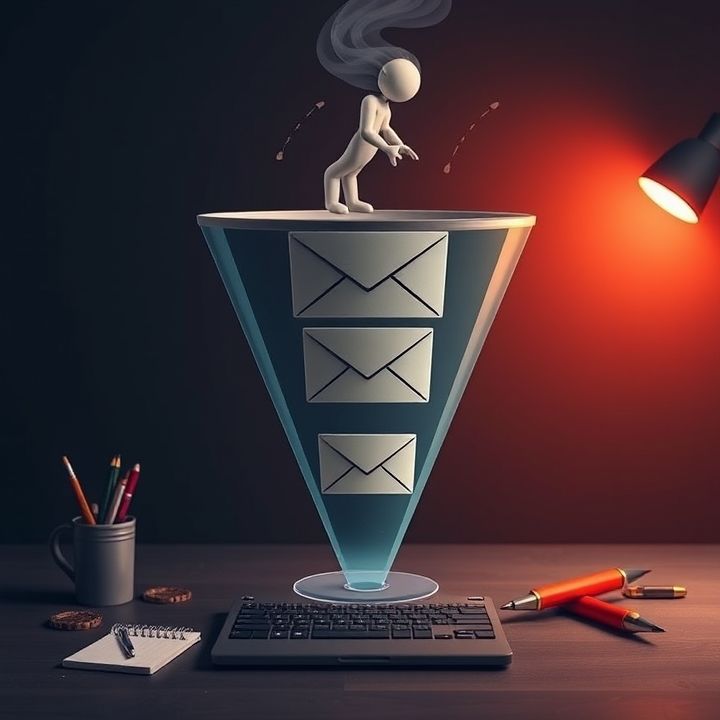Table of Contents
- Introduction
- Understanding the Customer Journey: Mapping Touchpoints for a Comprehensive View
- Identifying Key Stages in the Customer Journey and Their Impact on Email Strategy
- Segmentation and Personalization: Tailoring Email Content to Specific Journey Phases
- Designing Trigger-Based Email Sequences Aligned with Customer Actions
- Utilizing Behavioral Data to Refine and Enhance Email Engagement
- Assessing the Effectiveness of Email Sequences Through Journey Analytics
- Iterative Improvement: Continually Optimizing Email Sequences Based on Feedback
- Integrating Cross-Channel Insights for a Seamless Customer Experience
- Conclusion
- Frequently Asked Questions
Introduction
The realm of email marketing is rapidly evolving, and with it comes a powerful tool that promises to transform the way businesses engage with their audiences: customer journey mapping. This strategic practice goes beyond traditional marketing approaches by offering a comprehensive blueprint of a customer’s interaction with a brand. Imagine having the ability to anticipate your customers’ needs, craft personalized experiences, and ultimately drive conversion rates through the roof.
But what exactly does customer journey mapping entail, and how can it propel your email marketing success to new heights? In today’s competitive landscape, understanding every touchpoint along a customer’s journey is crucial for delivering the right message at the right time. Within this article, we’ll explore the secrets behind leveraging customer journey mapping to elevate your email campaigns.
Here’s a quick look at what we’ll delve into:
| Key Areas | Benefits |
|---|---|
| Understanding Customer Needs | Enhanced Personalization |
| Mapping Touchpoints | Increased Engagement |
| Optimizing Campaigns | Higher ROI |
So strap in and prepare to unlock the potential of customer journey mapping—your email marketing success is just around the corner!
Understanding the Customer Journey: Mapping Touchpoints for a Comprehensive View
Understanding the customer journey is crucial for businesses aiming to create effective marketing strategies. Mapping customer touchpoints provides a comprehensive view of the various interactions customers have with a brand, from the first encounter to the final purchase decision and beyond. This process involves identifying all the key stages a customer goes through, including awareness, consideration, decision, and post-purchase phases. By visualizing these touchpoints, businesses can gain insights into customer behavior and preferences, allowing them to tailor their marketing efforts to better meet customer needs.
Effective customer journey mapping requires collecting data from various sources such as website analytics, social media interactions, and customer feedback. By consolidating this information, businesses can identify pain points and opportunities for improvement within the customer journey. This, in turn, helps in creating a seamless and personalized experience across all channels. Ultimately, understanding and mapping customer touchpoints not only enhances customer satisfaction but also boosts brand loyalty and drives business growth. Investing time in this process equips businesses with the knowledge needed to craft targeted email sequences and other marketing campaigns that resonate with their audience, thereby fostering stronger connections and improving overall engagement.
Identifying Key Stages in the Customer Journey and Their Impact on Email Strategy
Identifying key stages in the customer journey is crucial for crafting effective email sequences. The journey typically includes stages such as awareness, consideration, decision, and retention. Each stage represents a different mindset and needs of the customer, thus influencing the type of content and messaging that should be delivered via email.
In the awareness stage, emails should focus on building brand recognition and providing valuable information that addresses the customer’s initial queries. As they move into the consideration stage, the focus should shift to offering more detailed insights, comparisons, and testimonials to help them evaluate their options.
When customers reach the decision stage, emails should aim to remove any final barriers to conversion by highlighting unique selling points, offering incentives, or addressing common objections. Finally, in the retention stage, the goal is to nurture the relationship through personalized content, exclusive offers, and feedback requests. By aligning email strategies with these stages, businesses can enhance engagement, guide prospects smoothly through the funnel, and ultimately drive conversions.
Segmentation and Personalization: Tailoring Email Content to Specific Journey Phases
Segmentation and personalization are crucial when crafting effective email sequences, particularly when aligning with specific phases of the customer journey. By segmenting your audience based on where they are in their journey, you can tailor email content to address their specific needs and preferences, thereby enhancing engagement and conversion rates.
For instance, in the awareness phase, emails should focus on informative content that introduces your brand and products to potential customers. This could include educational resources, detailed product information, or general industry insights.
As customers move to the consideration phase, emails should shift to comparative content that highlights benefits and differentiators, such as product comparison guides, testimonials, or case studies. Personalization here means updating the content to match each recipient’s specific interests or previous interactions.
Finally, in the decision phase, focus on driving action with promotional offers, limited-time discounts, or compelling calls-to-action that prompt a purchase.
Effective segmentation combined with personalization ensures that each email resonates more deeply with the recipient, fostering a more meaningful connection and ultimately guiding them smoothly through the sales funnel.
Designing Trigger-Based Email Sequences Aligned with Customer Actions
Designing trigger-based email sequences aligned with customer actions is a powerful way to enhance engagement and drive conversions. By understanding the customer journey and identifying key touchpoints, businesses can send targeted, timely emails that resonate with their audience. This involves mapping out the customer journey to pinpoint the moments when a customer is most likely to engage, such as after a product view, cart abandonment, or a successful purchase.
Trigger-based emails are sent automatically in response to specific customer actions, ensuring that the message is relevant and contextual. For instance, if a customer leaves a product in their shopping cart, an immediate follow-up email offering additional information or a discount can nudge them towards completing the purchase.
Moreover, these emails can be personalized to cater to the customer’s preferences and behavior, increasing the likelihood of engagement. By integrating customer data and analytics, businesses can further refine their email sequences, ensuring that the content is not only timely but also meaningful.
In summary, leveraging customer journey mapping to design trigger-based email sequences helps businesses connect with their customers in a more thoughtful and effective manner, ultimately leading to increased customer satisfaction and loyalty.
Utilizing Behavioral Data to Refine and Enhance Email Engagement
Utilizing behavioral data is crucial in refining and enhancing email engagement as it allows marketers to deliver more personalized and timely messages. By analyzing data such as open rates, click-through rates, and user interactions on previous emails, businesses can better understand what content resonates with their audience. This information helps segment the audience based on specific behaviors and preferences, enabling more targeted communication strategies.
When crafting email sequences, behavioral data can highlight patterns that inform content creation and scheduling. For instance, if a certain segment consistently opens emails in the morning, scheduling future emails at that time can increase engagement. Additionally, understanding the products or services that interest different segments allows for tailored recommendations, driving further interaction.
Further, behavioral data can pinpoint disengagement, signaling when to retarget or re-engage customers through special offers or alternative content. By leveraging these insights, brands can create a more dynamic and responsive email marketing strategy, ultimately fostering deeper connections with their audience and improving overall campaign effectiveness.
Assessing the Effectiveness of Email Sequences Through Journey Analytics
Assessing the effectiveness of email sequences through journey analytics is crucial for understanding how well these campaigns engage customers. Journey analytics offers insights into customer interactions, showing the path they take through various touchpoints. By analyzing this data, businesses can determine the effectiveness of each email within a sequence. Key performance indicators such as open rates, click-through rates, and conversion rates provide valuable metrics to assess if the emails are achieving their intended goals.
Furthermore, journey analytics can help identify the points where customers drop out or disengage, allowing marketers to adjust the email content or timing to better align with customer expectations. Segmenting customers based on their journey stages can also enhance personalization, making emails more relevant and timely. This leads to increased customer satisfaction and higher conversion rates. By continuously monitoring and analyzing journey data, organizations can refine their email sequences, ensuring they remain effective and responsive to the evolving needs of their audience.
Iterative Improvement: Continually Optimizing Email Sequences Based on Feedback
Iterative improvement in email sequences involves consistently optimizing based on feedback and performance metrics. By analyzing key indicators such as open rates, click-through rates, and conversion rates, marketers can gain valuable insights into what works and what doesn’t. Once the data is collected, it is crucial to segment it to understand different customer behaviors and preferences. This allows for a more personalized approach in the email sequence.
An effective strategy is to conduct A/B testing for different elements of the emails, such as subject lines, content, and call-to-action buttons. Testing helps in identifying the most engaging elements and understanding various customer preferences. After implementing changes, it’s important to continue monitoring performance to ensure improvements are effective.
Feedback from customers can be directly sourced through surveys or interactively within emails. This qualitative data provides insights that numbers alone cannot offer, helping to refine messaging further. Additionally, keeping an eye on industry trends and adjusting strategies to align with current standards can keep your email sequences relevant and effective.
The process of iterative improvement is about maintaining flexibility and a willingness to experiment, ensuring that email sequences remain engaging and valuable to recipients over time.
Integrating Cross-Channel Insights for a Seamless Customer Experience
Integrating cross-channel insights is essential for creating a seamless customer experience. By analyzing the interactions customers have across various channels—such as social media, websites, email, and in-store visits—businesses can gain a holistic view of the customer journey. This data can then be leveraged to craft personalized email sequences that resonate with the customer’s specific needs and preferences at different stages of their journey.
Start by mapping the customer’s journey and identifying the critical touchpoints across channels. Use analytics tools to collect data on customer behavior and preferences, which can help in segmenting audiences more effectively. These insights enable businesses to tailor their email content, timing, and frequency to align with what the customer seeks to achieve or resolve at each interaction point.
Cross-channel integration ensures that customers receive consistent messaging and experience, no matter where they interact with the brand. For instance, a customer showing interest in a specific product on a website could trigger a follow-up email offering a discount or additional information, enhancing the chances of conversion. Ultimately, utilizing cross-channel insights not only improves customer satisfaction but also drives engagement and loyalty.
Conclusion
In conclusion, customer journey mapping serves as a pivotal foundation for propelling your email marketing efforts to new heights. By meticulously outlining each touchpoint and stage within the customer journey, businesses can hone their email strategies to effectively engage and convert prospects. The integration of segmentation and personalization ensures that email content resonates harmoniously with individual needs, thereby fostering deeper connections and driving actionable results. Moreover, designing trigger-based email sequences aligned with customer actions maximizes engagement through timely and relevant interactions.
Leveraging behavioral data further refines email marketing strategies, allowing for dynamic responsiveness to changing customer preferences and engagement patterns. The iterative process of continuously optimizing email sequences based on performance analytics ensures lasting effectiveness and relevance. Harnessing cross-channel insights further amplifies these efforts, creating a seamless, consistent experience that not only delights customers but also strengthens brand loyalty.
Embracing customer journey mapping as a strategic tool empowers businesses to create highly effective email campaigns that not only meet but exceed customer expectations—ultimately leading to greater success in achieving marketing goals.

